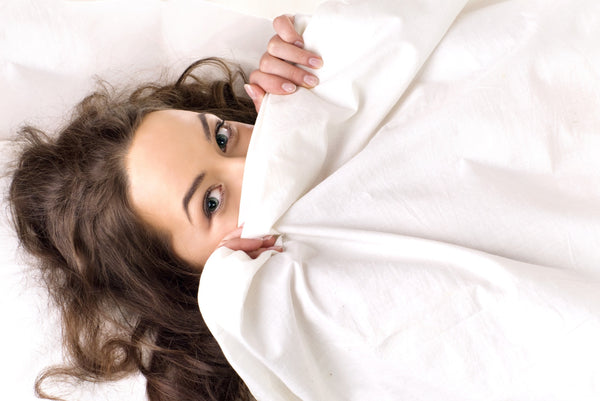15 Dangerous Sleep Disorders

Many people experience difficulty falling asleep, or may suddenly fall asleep as a result of sleep problems. According to the American Sleep Association (ASA), approximately 50 to 70 million American adults are affected by common sleep disorders each year. In addition, the ASA reports 48% of adults to experience snoring, 37.9% experience falling asleep during the day unintentionally, and 4.7% report falling asleep while driving at least once per month. These conditions can be extremely dangerous to both the person suffering and those around them.
What are Sleep Disorders?
A sleep disorder is classified as a condition that disrupts your ability to fall asleep, stay asleep, or get enough sleep at night. These conditions can become increasingly dangerous, as a lack of sleep can lead to many unwanted side effects.
Importance of Sleep
High-quality sleep that includes REM sleep is important as it allows the brain adequate time to rest, relax, and reset. In addition, deep sleep allows a person to:
- Preserve memories
- Regulate hormones
- Rid the brain of harmful toxins
- Control emotions
- Repair damaged tissue
The Dangers of a Lack of Sleep
Experts recommend sleeping approximately 8 hours each night. When we do not maintain the recommended amount of sleep or quality, rejuvenating sleep, you are at an increased risk of experiencing:
- Depression
- Diabetes
- Obesity
- Conflicts in a relationship
- A weakened immune system
- Learning disorders
- Behavior disorders
- Emotional disorders
How Common are Sleep Disorders?
Experts report more than 50 million people (and potentially up to 70 million) in the United States alone suffer from some type of sleep-related disorder, causing them to be unable to fall asleep, stay asleep, or affect the quality of sleep a person is getting. Sleep-wake cycles occur naturally throughout the day, and are a part of the body’s circadian rhythm, telling a person when it is time to wake up and go to bed.
What are the Causes of Sleep Disorders?
Disturbed sleep can cause many negative effects on a person’s quality of life, leaving them unable to maintain a healthy daily life, such as maintaining daily chores, healthy relationships, or simply the ability to get out of bed. But, what causes these issues?
Sleep disorders are commonly linked to emotional, mental health, and physical issues; however, they may also be linked to:
- Obesity: an excessive amount of fat as a result of being overweight, specifically around the nose and throat. This may block your breathing, resulting in obstructive sleep apnea, which increases the risk of pauses in breathing as you sleep
- Mental health: depression, mental illness, stress, and trauma are linked to some of the most common sleep disorders, including night terrors and insomnia.
- Changes in hormones: Women experience significant hormone imbalances at various times throughout their life as a result of menstruation, pregnancy, menopause, or other medical conditions. A change in hormones can affect a person’s ability to fall asleep, or remain asleep.
- Chronic medical illness: Common sleep disorders may be the result of chronic medical conditions, such as Alzheimer’s, Parkinson’s, heart disease, cancer, or other chronic conditions affecting a person’s daily life.
- Prescription medication: Millions of people are undergoing some type of treatment with the help of prescription medication; however, many of these medications can cause trouble sleeping. Common medications that disrupt sleep include antidepressants, asthma medication, and antihistamines.
What are Parasomnia Sleep Disorders?
Parasomnia sleep disorders are classified as sleep disorders that involve undesirable and/or unusual physician events that affect a sleeping person. Parasomnia can occur at any sleep stage, including just before falling asleep, while you are asleep, or upon waking up. Parasomnia sleep disorders include:
- Sleep terrors
- Sleep talking
- Confusional arousal
- Exploding head syndrome
- Restless leg syndrome
Why Parasomnia Sleep Disorders can be Dangerous
A parasomnia sleep disorder can be dangerous to not only the sleeping person, but their bed partner as well. These disorders significantly affect a person's ability to control body movements. During deep sleep, a person suffering from parasomnia night terrors often acts out the nightmare they are experiencing, increasing the risk of injuring themselves or those around them - especially if it is a violent dream.
Parasomnia creates an increased amount of stress on those suffering, which in turn affects their already restless sleep.
15 Dangerous Sleep Disorders
There are a whole host of sleep disorders, with some of them being more troublesome than others, including the below.
1) Nightmares
A nightmare disorder is classified as experiencing vivid dreams, increasing anxiety, fear, and terror. When a person experiences a nightmare, they wake suddenly, and have an increased difficulty falling back to sleep. Nightmares are often remembered in detail the next morning, and can be caused by illness, anxiety, grief, or a reaction to certain medications. Nightmares leave a person unable to easily fall back to sleep as a result of the increase in fear.
2) Night Terrors
Unlike nightmares, night terrors are much more intense, and are often not remembered the following day. Sleep terrors are most common in children; however, can be experienced by a person of any age. Night terrors are not a dream - they are an intense reaction to the transition from one sleep cycle to the next, often beginning two to three hours after falling asleep. During night terrors, a person cannot talk or respond when being spoken to, and is often inconsolable for upwards of 15 minutes before falling back to sleep.
3) Sleepwalking
During a sleepwalking event, a person looks as if they are awake, however, they are in a deep non-rem sleep cycle. During non-REM sleep, your body functions slow down, including a reduction in blood pressure, heart rate, and brain activity. Sleepwalking is common among children between the ages of 5 to 12 years old, and typically slows or stops altogether when they reach their teenage years. Sleepwalking is dangerous to the person, as they are unaware of their actions.
4) Insomnia
Insomnia is one of the most common sleep disorders diagnosed among American adults. Sleep specialists report insomnia is classified as an increasing difficulty falling asleep, or staying asleep. While insomnia itself may not be deadly, the symptoms associated with sleep deprivation, as a result, are deadly. This condition may be temporary or chronic, meaning it can last for a short time or lifelong.
5) Confusional Arousal
Confusional arousal occurs as you wake from a deep rapid eye movement (REM) or non-rem sleep. A person is often slow to respond to the environment around them, slow to follow commands, and confused as to what is going on around them. Confusional arousal often happens early in the night, and is not remembered the following morning.
6) Kleine-Levin Syndrome (KLS)
Kleine-Levin Syndrome, commonly referred to as Sleeping Beauty Syndrome, is defined as a person sleeping almost all day, upwards of 23 hours per day, for several days, weeks, or months at a time. A person living with KLS is difficult to wake; however, when they do wake up, they experience unusual compulsive behaviors, an increased sex drive, hallucinations, binge eating, and even childlike behaviors. It is important to note that a person living with Kleine-Levin syndrome may experience normal sleep patterns for one year between abnormal patterns.
7) Fatal Familial Insomnia (FFI)
Fatal Familial Insomnia (FFI) is a dangerous sleep disorder that starts with experiencing difficulty falling asleep that gradually increases as time goes on until a person is unable to sleep altogether. Common symptoms associated with FFI make this disorder extremely dangerous, as there is an increased risk of injury due to daytime fatigue. Fatal Familial Insomnia is an untreatable condition resulting in abnormal autonomic functions, including the ability to regulate blood pressure, heart rate, and body temperature. FFI ultimately leads to a coma or death, and often comes with a life expectancy of 18 months.
8) Sleep Paralysis
Sleep paralysis is classified as the temporary inability to move your arms, legs, or trunk of the body. Temporary sleep paralysis often is more common when a person is falling asleep, or when they are waking. Common symptoms associated with sleep paralysis include hallucinations, vivid dreams, and feeling like there is a weight, or pressure, on your chest.
9) Sleep-Related Hallucinations
A common type of parasomnia is sleep-related hallucinations. These hallucinations occur early in the night, and leave a person to see, hear, or feel things that are not real, resulting in a significant increase in fear, anxiety, and high blood pressure. People experiencing these hallucinations often quickly flee their sleep environment to get away from what they believe is true.
10) Narcolepsy
A person living with narcolepsy cannot regulate their sleep-wake cycle, resulting in unwanted sleep during the day, or not being able to sleep at night. Narcolepsy can be extremely dangerous, as involuntary sleep during the day can occur at any time, regardless of the activity a person is doing, such as driving a vehicle, or working with heavy machinery. Common side effects of this condition include hypotonia (decreased muscle tone), hallucinations, or temporary paralysis.
11) REM sleep behavior disorder
An REM sleep behavior disorder, or rapid eye movement disorder, is extremely dangerous to the person and their sleeping partner, as a person will unconsciously act out the dreams they are experiencing throughout the night.
12) Sexsomnia
Sexsomnia is a sleep disorder in which a person subconsciously acts out sexual activities, such as masturbation or sexual intercourse while being asleep. It is often not remembered the following day, as the person does not know they are engaging in these sexual acts.
13) Sleep Apnea
Obstructive sleep apnea is a common sleep disorder causing a person to snore loudly, and to periodically stop breathing through the night. Common symptoms associated with sleep apnea include an irregular heart rate, an insufficient amount of oxygen being supplied to the brain, and sudden death.
14) Sleep Bruxism
Sleep bruxism is excessive grinding or clenching of the teeth as a person is sleeping, resulting in serious side effects, such as jaw disorders, intense headaches, and damage to the teeth. Severe effects of sleep bruxism can significantly impact a person’s quality of life.
15) Sleep Eating Disorders
Sleep-related eating disorders are a common type of parasomnia resulting in a person unconsciously eating foods while they sleep. A person may eat foods they normally would not, eat inedible or harmful foods, unhealthy foods, or too much food. A person also may sustain one or more injuries from preparing or cooking the food, as they are unaware of what they are doing.
How are Sleep Disorders Diagnosed?
Sleep disorder diagnosis must be obtained by a medical professional through various testing. A sleep physician will begin by asking you and your bed partner about any symptoms you may experience as you sleep, family and medical history if you experience alcohol abuse, and current medications you are taking. You will then be scheduled for various tests including:
- Polysomnogram: sleep study conducted in a clinical setting by a sleep specialist where you can be monitored as you sleep. Many factors are monitored, such as heart rate, eye movements, brain waves, breathing patterns, and movements.
- Video electroencephalogram: an EEG is used to record brain activity
- CT scan or MRI scans: used to detect neurological disorders that may be impacting sleep, or causing the sleep disorder.
How are Sleep Disorders Treated?
Treatment for a sleep disorder depends on many factors, including the type of disorder, personal and family history, and identifying current symptoms. Sleep medicine specialists report the management for rem sleep behavior disorders and non REM sleep disorders to include:
- Sleeping 7 to 9 hours
- Turning off all lights, TVs, and electronic devices
- Maintain a schedule
- Avoid caffeine
- Take medication, include any sleep medicine, as prescribed
- Sleeping on a high-quality mattress
Eco Terra offers luxury, affordable high quality mattress and mattress topper options designed to help you fall asleep, and stay asleep each night. By using 100% natural latex, you are sure to love sleeping in your synthetic-free, safe sleep environment to get the best sleep possible.







